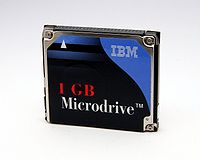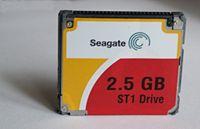- Microdrive
-
Microdrive (MD) is a brand name for a miniature, 1-inch hard disk designed to fit in a CompactFlash (CF) Type II slot. The release of similar drives by other makers has led to them often being referred to as 'microdrives'. However, 'microdrive' is not a genericized trademark[1] and manufacturers other than IBM up to 2003 and Hitachi after do not officially refer to these drives as Microdrives. Some other companies such as Sony have licensed the name and sell re-branded versions, others such as Seagate have their own designs which fit in the same form factor.
These drives fit into any CompactFlash II slot; however, they may consume more power than flash memory (currents on the order of 190 mA, peak 310 mA, at 3.3 V) and therefore may not work in some low-power devices (e.g., handheld computers). Nevertheless, they have some benefits over flash memory in terms of the way data is stored and manipulated. Microdrives can store 8 GB or more, but must be formatted for a file system which supports this capacity, such as ext3 or NTFS or FAT32 which might not be supported by older CompactFlash hosts. To avoid this problem, the operating system may partition a drive so that each filesystem is smaller than 4GB.
As of 2011, Microdrives are viewed as obsolete, having been eclipsed by solid-state flash media in read/write performance, storage capacity, durability, physical size, and price.
Contents
History
The Microdrive was developed and launched in 1999 by IBM with a capacity of 170 MB. Capacity expanded to 8 GB by 2006. They weigh about 16 g (~1/2 oz), with dimensions of 42.8×36.4×5mm (1.7×1.4×.2in). They were the smallest hard drives in the world at the time. From 1999 to 2003, they were known as IBM Microdrives, and from 2003 as Hitachi Microdrives, after Hitachi bought IBM's hard drive division. Microdrive was a registered trademark by IBM and Hitachi for each period.
IBM initially released 170 MB and 340 MB models. The next year, 512 MB and 1 GB models became available. In December 2002 Hitachi bought IBM's disk drive business, including the Microdrive technology and brand. By 2003, 2GB models were introduced. Over the years, larger sizes have become available. There are licensed branded Sony models called Sony Microdrive. These are re-badged Hitachi units.
In 2004, Seagate launched 2.5 and 5 GB models, and tends to refer to them as either 1-inch hard drives, or CompactFlash hard drives due to the trademark issue. In 2005 Seagate launched an 8 GB model.
In 2004, a Chinese manufacturer called GS Magic started marketing small form factor HDDs for CF. They have, however, been sued by Hitachi for patent infringement of the IBM design [1] (as opposed to Seagate, which used its own technology). These drives are generally cheaper and of lower quality than Hitachi and Seagate drives and have received a plethora of bad reviews.*
- A link to the product announcement [2], but as of yet, the company's website is down, the US distributor said they went out of business in 02/07, and no mention of the lawsuit or the reviews has been found.
Microdrive models by timeline
Date of release of large sizes.
1999: 170 megabyte (IBM MD170/A) 1999: 340 megabyte (IBM) 2000: 512 megabyte, 1 gigabyte (IBM) 2003: 2 gigabytes (Hitachi) 2004: 4 gigabytes (Hitachi), 2.5 and 5 gigabytes (Seagate) 2005: 6 gigabytes (Hitachi), 8 gigabytes (Seagate) 2006: 8 gigabytes (Hitachi) Availability
As of 2006 the most commonly-seen microdrives are the smaller sizes, up to 1GB. Larger (2GB to 8GB) drives, such as the 4GB and 6GB Hitachi models, the 5GB and 8GB Seagate models and the 2.2GB Magicstor drive are also available but are often embedded in Pocket hard drives, "high end" mobile phones, music players, and other entertainment devices. Such embedded devices are far more popular than the loosely-sold Microdrives intended as a CompactFlash card alternative.
In the United States most electronics shops do not sell separate Microdrives as they may find it economically unviable to stock them due to the fast-moving nature of the market, however they are readily available on several websites. But in most developed Asian cities such as Hong Kong and Tokyo, a 8GB version of the Seagate ST1 are selling at the price (as of second quarter 2006) as low as USD $220 in retail shops, and under USD $50 on eBay.
Applications
- CF to IDE adaptors and USB card readers enable microdrives to be used in computers, they can then be formatted with any filesystem that the operating system supports such as ext3 or NTFS or FAT32. It is even possible to run an operating system directly from the Microdrive. Such a system would be rather sluggish for today's standards but still a viable option for some embedded applications. IDE adaptors are inexpensive because, like the PCMCIA adaptors, they have no integrated circuits.
- Some high capacity USB drives are microdrives with a USB interface; they can often be recognized by a rectangular shape. These devices are sometimes called Pocket hard drives. However there is currently a trend for selling desktop PCs with integrated multi-card readers. If this trend continues this could eliminate the need to integrate them into pocket hard drives with USB connections.
- The original JVC Everio camcorders (GZ-MC200/MC100) used 4GB IBM/Hitachi Microdrives as storage instead of the magnetic tape or DVD more commonly seen in products of this type. Current Everio models use the more common 2.5" HDDs.
- Some PDA users use Microdrives to boost the storage capacity of their PDA. The LifeDrive has an integrated 4 gigabyte microdrive as its main selling point.
- Microdrives are found in the discontinued iPod mini and Creative Zen Micro mp3 players, among others. Companies making such players order the Microdrives in large quantities, which can mean that it is cheaper to buy an mp3 player with an integrated Microdrive than a separate Microdrive to add to an expandable mp3 player. An example is the Creative MuVo; many of these were bought up by those interested in purchasing a Microdrive and stripped for their Microdrive which was then replaced by a lower capacity CompactFlash card.
- When combined with a PCMCIA adaptor and used in a laptop Microdrives can be a viable alternative to USB flash drives purely due to their price. The use of Microdrives over chip-based CF cards is unlikely to make any notable difference to the battery life of the laptop, and any impact that would damage the Microdrive is likely to break other components of the laptop as well. However these devices cannot be used with ordinary desktop PCs unless they are fitted with PCI PCMCIA adaptors or CF card readers.
- There are third-party devices intended to let users of the Sony PSP use memory cards other than Memory Sticks. Some claim to be compatible with MicroDrives, and some even come with a MicroDrive in the package. However, while such converters work perfectly for other kinds of flash memory (SD and CompactFlash), it is no longer possible (due to firmware upgrades) to use actual MicroDrives on the PSP. The acceptable timeout delay has been decreased from the first firmware revisions, and as a result loading a game from the hard disk results in a timeout error.
Sometimes when a device with an integrated Microdrive stops working the device is taken apart and stripped of its Microdrive, which is then sold on. Unfortunately, Microdrives taken from such devices may not work in digital cameras. These drives must be accessed using ATA mode, which is not supported in all devices. Such drives, therefore, do not sell for nearly as much as CF-enabled Microdrives. An ATA-only Microdrive can be used in simple pass-through CompactFlash to IDE/SATA adapters for embedded use, however most digital cameras and some card readers will be unable to access the device.
Devices with integrated microdrives
- Apple iPod mini: 4GB and 6GB Hitachi (CF mode disabled)
- Creative MuVo: 4GB Hitachi (CF mode disabled in later models)
- Creative ZEN Micro: 5GB/6GB Seagate
- Creative ZEN MicroPhoto: 4GB/8GB Seagate
- Dell Digital Jukebox: 5GB Seagate ST1
- Hewlett-Packard Photosmart 475: Unknown (1.5GB available to user)
- HTC Athena (Dopod U1000, HTC Advantage, T-Mobile Ameo): 8GB Unknown (most suggest Hitachi)
- iriver H10: 5GB and 6GB Seagate
- Mio 269/269+ : 2.5GB Seagate
- Nokia N91: 4GB Hitachi
- palmOne LifeDrive: 4GB Hitachi
- Rio Carbon: Seagate ST1 5GB
- Sharp Zaurus Sl-C3000
- RCA Lyra H106A Series: 6GB Seagate
- SAMSUNG YH-820: Seagate ST1 5GB
- Sharp Zaurus Sl-C3100
- Sharp Zaurus Sl-C3200
- Sony NW-A1000: 6GB Hitachi
- TrekStor vibez: 8GB/12GB Cornice Dragon
- Olympus M:robe m100 mp3 player
- Navman iCN 650: 2GB Hitachi
- iriver E10: 6GB Hitachi
- Philips PSA612: 4GB Hitachi
Microdrive Advantages
- Until 2006, Microdrives had higher capacity than CompactFlash cards.
- Microdrives allow more write cycles, making them suitable for use as swapspace in embedded applications.
- Microdrives might be better at handling power loss in the middle of writing. Flash storage always needs to move some old data around while writing, to ensure the flash's finite write life is consumed equally; if there were a bug in the wear levelling algorithm it could cause data loss if the card were unplugged at the exact wrong time. Data on a magnetic hard drive is modified in place, and hard drive algorithms have many years more experience and testing over Flash.
Microdrive Disadvantages
- As of 2006, Microdrive's capacity advantages were exceeded by CompactFlash cards[2](which are the same size and are often compatible with each other), and USB flash drives.[3]
- Being mechanical devices they are more sensitive to physical shock and temperature changes than flash memory, though in practice they are very robust and manufacturers have added several features to the more recent models to improve reliability.
- A microdrive will generally not survive a 4 foot (1.2 metres) drop onto a hard surface whereas CF cards can survive much higher falls.
- Newer Microdrives have a mechanism to hold the heads off the platter while the device is not in use. Early IBM models do not have this—when one gently shakes such a drive one can hear the heads click from side to side.[citation needed]
- Microdrives are not as fast as the high-end CompactFlash cards; they generally operate at around 4–6 megabytes per second while high-end CF cards can operate at 45 megabytes per second. This may cause problems for photographers who shoot sequences of large images in rapid succession.
- They are not designed to operate at high altitudes (over 10,000 feet), but can be safely used on most commercial aircraft as cabins are generally pressurized.
- Outside of the professional photography market, Microdrives have more limited popularity by general consumers because many newer compact cameras lack CF/CF II slots due to the increasing popularity of portable flash media.
- Only high capacity models are manufactured, as it is not profitable to make low-capacity Microdrives. At the end of 2005 only capacities above 2 gigabytes are manufactured while 256MB and 512MB CompactFlash cards were still in production. Lower capacities are still readily available second hand on eBay but these are usually the same price as CF cards of the same size.
- Unlike flash memory, Microdrives require power even when no data is being transferred to them to keep the disc spinning. As a result many devices such as the iPod mini leave the drive switched off for most of the time while periodically starting it up to fetch data from it to fill the device's buffer. Microdrives will switch off after idling for more than a few seconds to counter this problem however this means that more time is lost constantly spinning the drive up. This effect would be particularly problematic if an operating system is being run from the drive. However the drive can be forced to stay running if the host device is programmed to write random bits of data to it.
- Certain bus-powered CF card readers lack the power needed to run a Microdrive although they do take CF II cards, when using such a device it will usually be detected by the host but errors will occur once the user attempts to access the drive.
- Some "OEM Only" drives use the CompactFlash form factor but only provide a 5V IDE/ATA interface. These will not work in readers or devices which expect a 3.3V interface and full CompactFlash functionality [3],
- Microdrives also require some time to spin up, this is very low when compared to regular hard drives but not as fast as flash memory.
- Since Microdrives are often integrated in another device this can cause trouble if the drive breaks, it is usually the most fragile component of the device and if the device is out of warranty it can be very difficult to replace the drive
CF hard drive models by manufacturer
Many smaller sized models are no longer offered, as they have been supplanted by flash memory.
IBM MicroDrive (now manufactured by Hitachi)
- 170 megabyte
- 340 megabyte
- 512 megabyte
- 1 gigabyte
- 4 gigabyte
Hitachi MicroDrive
- 512 megabyte
- 1 gigabyte
- 2 gigabyte
- 3 gigabyte
- 4 gigabyte
- 6 gigabyte
- 8 gigabyte
IBM and Hitachi models fitted with 128 KB of cache memory
GS Magic
- 2.5 gigabyte
- 4 gigabyte
- 5 gigabyte
- 6 gigabyte
- 8 gigabyte
- 12 gigabyte
These Seagate models are fitted with 2 MB of cache memory
Sony Compact Vault
- 2 gigabyte (rebadged Hitachi)
- 4 gigabyte (rebadged Hitachi)
- 5 gigabyte
- 8 gigabyte
Cornice
- 4 gigabyte
See also
- Digital cameras
References
- ^ http://news.sel.sony.com/en/press_room/b2b/media_app_systems/release/9297.html "Microdrive" is a registered trademark of Hitachi Global Storage Technologies
- ^ SanDisk introduces the world’s highest capacity card for professional photographers - the 16-gigabyte SanDisk Extreme III CompactFlash
- ^ Corsair launches 16GB Flash Voyager drive
External links
- Review: IBM's 1GB Microdrive—Review on MP3 Newswire
- Hitachi Global Storage Technologies (HGST)
- Review of Seagate ST1 5 GB 1-inch hard disk for CF
Hitachi Divisions and
subsidiariesCurrentHitachi Cable (Hitachi Cable Manchester) · Hitachi Canadian Industries · Hitachi Capital · Hitachi Construction Machinery (Hitachi Construction Machinery (Europe)) · Hitachi Consulting · Hitachi Data Systems (BlueArc) · Hitachi Electronics · Hitachi Global Storage Technologies · Hitachi ID Systems · Hitachi Maxell · Hitachi Medical Systems · Hitachi Rail · JECSDefunctEuclid Trucks1 · Fabrik1
Joint ventures and
shareholdingsAgility Trains (40%) · GE Hitachi Nuclear Energy (40%) · Hitachi-LG Data Storage · NEC Casio Mobile Communications (9.26%) · Nippon Columbia (18.21%) · Renesas Electronics (30.62%) · Telcon Construction Solutions (60%)Products, services
and standardsCurrentALiS · D-VHS · EMIEW · Hitachi Adaptable Modular Storage 2000 · Hitachi DX07 · Hitachi Starboard · Locomotives · Hitachi Magic Wand · Multiple units · Hitachi 917 · Hitachi SR8000 · Hitachi Travelstar · Hitachi TrueCopy · LS-R · M8 · Stacked Volumetric Optical Disk · SuperH · Universal Storage PlatformDefunctH8 Family · HD64180 · HITAC · HITAC S-810 · Hitachi 6309 · Hitachi Deskstar · Hitachi Flora Prius · Hitachi G1000 · Hitachi Hatsukaze · Hitachi SR2201 · Hitachi T.2 · Hitachi TR.1 · M6 · MicrodrivePeople Places Other DKB Group · HDMI Licensing · Hitachi 3Tours Championship · Hitachi Data Systems History · The Hitachi Foundation · Hindu Hitachi Scholarships · Hitachi SunRockers · Kashiwa Reysol
Memory cards Main articles 
Types CompactFlash (CF) • Express Card • JEIDA • MultiMediaCard (MMC) • Memory Stick (MS/MS-PRO) • miCard • Microdrive (MD) • MiniCard • P2 • PC Card (PCMCIA, CardBus, CardBay) • Secure Digital (SD) • SmartMedia (SM) • SxS • Universal Flash Storage (UFS) • USB • xD-PictureCategories:- Hard disk drives
- IBM storage devices
Wikimedia Foundation. 2010.






